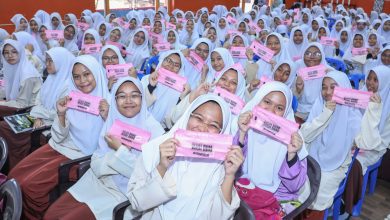

Hosted by Professor Dr. Ranjit Singh Gill, Professor and Deputy Dean, Faculty of Social Sciences, Acting Head of School, the QIU View session titled “Advocating Inclusion: Mindsets and Myths” featured two speakers, Ummu Hani binti Yahaya, lecturer of Early Childhood Education and Johanna Maria Means, Senior Lecturer of Special Needs Education.
This session uncovered how mindsets need to be shifted through explaining the need to adopt the right perspective about special needs and inclusive education.
“There are an estimated 400,000 individuals registered with special needs, but I believe there are many more who are not registered. This is mainly due to the social stigma of special needs and inclusive education. Not all students are truly being supported to the best of their abilities due to this fact,” said Johanna.
It’s time to silence the never-ending stereotype and correct the misconceptions so that children with learning disabilities get the help they very much need!
“Malaysia hasn’t caught up with inclusive education as a whole and it still poses a huge problem to many students. Autism, around the world, has one of the highest diagnosis as well as ADHD, and dyslexia is also on the rise,” said Johanna.
Resources and services offered or available in Malaysia?
“We’ve social resources in terms of education and advocacy, namely, the National Autism Society of Malaysia (NASOM) and Kiwanis Down Syndrome Foundation.
“In a collaborative effort, NGOs and the Ministry of Education run outreach programmes to aid the ones in need and live off the grid with restricted access to education and basic services. The remote community requires extra support, especially non-typically developing children,” Hani said.
Johanna shared the differences between integrated and segregated schooling and inclusive education.
In inclusive education, all students will have equal opportunities for participation. As for integration, students with disabilities are sometimes put in a normal classroom, for art or physical education while segregation are schools specially for special needs students.
When speaking of changing mindset, Hani said that it all begins with you. It’s our mindsets, misconceptions, beliefs that are clouding our judgement. Children with special needs missed early intervention. However, an inclusive education with early intervention helps foster the skills a child needs for later life.
Teachers with the will to learn and relearn things, together with adequate training provided by the school as well as good facilities, are attributes to a successful inclusive education.
According to Johanna, one of the biggest obstacles in Malaysia is that not everyone accepts special education. Unless the school and the community are on board, a successful inclusive programming can’t be achieved.
Based on a research, ‘How do children benefit from inclusion?’, inclusion is in the best interests of all children and is most effective when enacted as early as possible. In addition, there is no evidence to suggest that inclusion leads to decreased academic, social, or later life outcomes. Besides, children with disabilities benefit from being included in the general education classroom in both the short and the long term. Typically, developing children show benefits while participating in inclusive settings.
Gisele Soo
============================================
Get your local news fast. Download the Ipoh Echo App on your mobile. Available on both Google Playstore and Apple Appstore.


